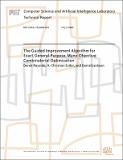Browsing Computer Science and Artificial Intelligence Lab (CSAIL) by Title
Now showing items 1444-1463 of 3804
-
The Graphical Typewriter: A Versatile Remote Console Idea
(1964-01-01)It would be useful to develop a combination typewriter-plotter along the lines described below. The device could be coupled to a telephone line with a reasonably small amount of electronics -- mostly relays. -
Graphite: A Distributed Parallel Simulator for Multicores
(2009-11-09)This paper introduces the open-source Graphite distributed parallel multicore simulator infrastructure. Graphite is designed from the ground up for exploration of future multicore processors containing dozens, hundreds, ... -
The Grasping Problem: Toward Task-Level Programming for an Articulated Hand
(1990-05-01)This report presents a system for generating a stable, feasible, and reachable grasp of a polyhedral object. A set of contact points on the object is found that can result in a stable grasp; a feasible grasp is found ... -
Green Theorems and Qualitative Properties of the Optical Flow
(1991-04-01)How can one compute qualitative properties of the optical flow, such as expansion or rotation, in a way which is robust and invariant to the position of the focus of expansion or the center of rotation? We suggest a ... -
The Greenblatt Chess Program
(1969-04-01)Since mid-November 1966 a chess program has been under development at the Artificial Intelligence Laboratory of Project MAC at M.I.T. This paper describes the state of the program as of August 1967 and gives some of the ... -
Grey Scale Display Slave
(MIT Artificial Intelligence Laboratory, 1974-05)The programs SNAP and ZSLAVE are components of a new grey scale display system. The object is to produce photographs, from a computer display, which have grey scale resolution comparable to that of a the visual input devices ... -
GROK Doc: An Image Display Tool
(MIT Artificial Intelligence Laboratory, 1986-04-14)The image display tool GROK provides a facility for displaying images on the black-and-white screen of a Symbolics 3600 monitor. It allows display of images and their manipulation through a special window it manages. Images ... -
Group Communication Specifications: A Comprehensive Study
(1999-09)View-oriented group communication is an important and widely used building block for many distributed applications. Much current research has been dedicated to specifying the semantics and services of view-oriented Group ... -
Grouping For Recognition
(1989-11-01)This paper presents a new method of grouping edges in order to recognize objects. This grouping method succeeds on images of both two- and three- dimensional objects. So that the recognition system can consider first ... -
The GSL Cookbook
(MIT Artificial Intelligence Laboratory, 1989-03)This cookbook contains recipes prepared for the GSL (Graduate Student Lunch) at the Massachusetts Institute of Technology Artificial Intelligence Laboratory. -
GT40 Utility Pograms and the LISP Display Slave
(MIT Artificial Intelligence Laboratory, 1974-01)This memo describes two GT40 programs: URUG, an octal micro-debugger: and VT07, a Datapoint simulator and general display package. There is also a description of the MITAI LISP display slave, and how it uses VT07 as a ... -
Guaranteed in-order packet delivery using Exclusive Dynamic Virtual Channel Allocation
(2009-08-18)In-order packet delivery, a critical abstraction for many higher-level protocols, can severely limit the performance potential in low-latency networks (common, for example, in network-on-chip designs with many cores). While ... -
Guaranteeds Partial Key-escrow
(1995-08) -
Guaranteeing Spoof-Resilient Multi-Robot Networks
(July 2015)Multi-robot networks use wireless communication to provide wide-ranging services such as aerial surveillance and unmanned delivery. However, effective coordination between multiple robots requires trust, making them ... -
Guardians for Concurrent Systems
(MIT Artificial Intelligence Laboratory, 1980-12)In this paper we survey the current state of the art on fundamental aspects of concurrent systems. We discuss the notion of concurrency and discuss a model of computation which unifies the lambda calculus model and the ... -
A Guide to ITS Operations: Useful Spells and Incantations
(MIT Artificial Intelligence Laboratory, 1982-01-27)It is said that it is not wise to dabble in the Arts without care and caution, for the spell is at once subtle and dangerous: Look herein! For if you read carefully and closely, you can incant a Word of Magic, and the ... -
The Guided Improvement Algorithm for Exact, General-Purpose, Many-Objective Combinatorial Optimization
(2009-07-03)This paper presents a new general-purpose algorithm for exact solving of combinatorial many-objective optimization problems. We call this new algorithm the guided improvement algorithm. The algorithm is implemented on top ... -
Guided Time Warping for Motion Editing
(2007-08-01)Time warping allows users to modify timing without affecting poses. It has many applications in animation systems for motion editing, such as refining motions to meet new timing constraints or modifying the acting of ... -
GURLS: a Toolbox for Regularized Least Squares Learning
(MIT CSAIL, 2012-01-31)We present GURLS, a toolbox for supervised learning based on the regularized least squares algorithm. The toolbox takes advantage of all the favorable properties of least squares and is tailored to deal in particular with ...


















